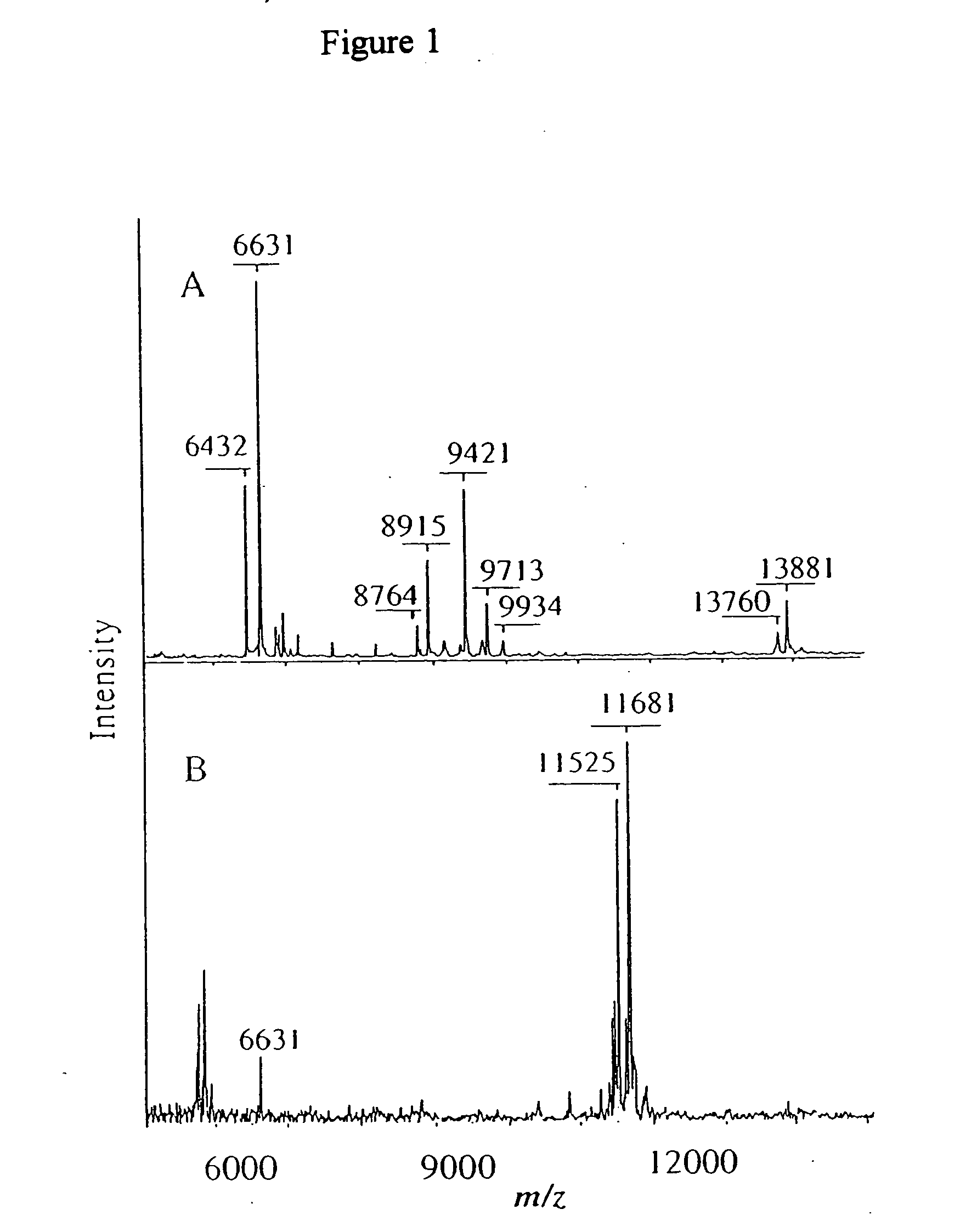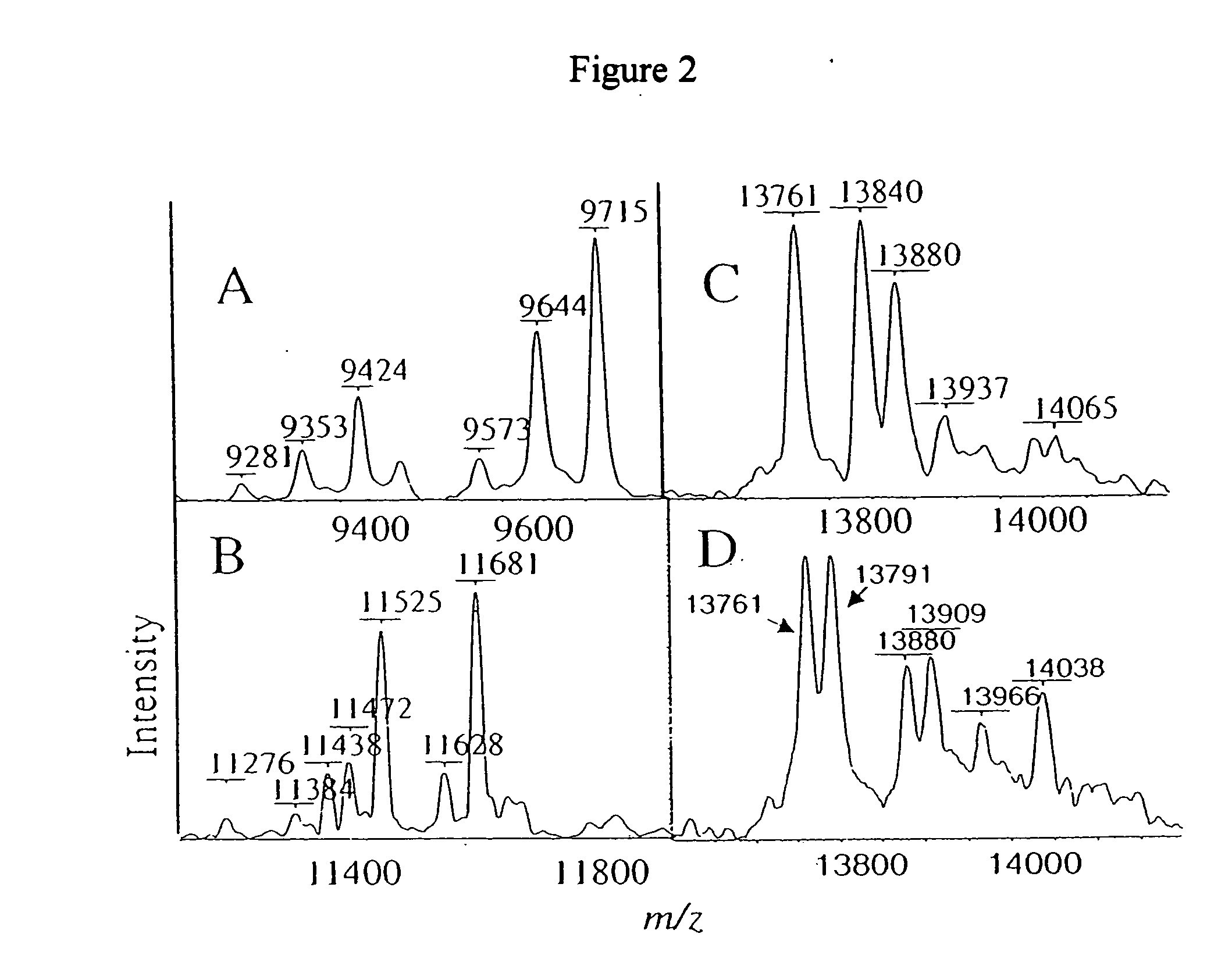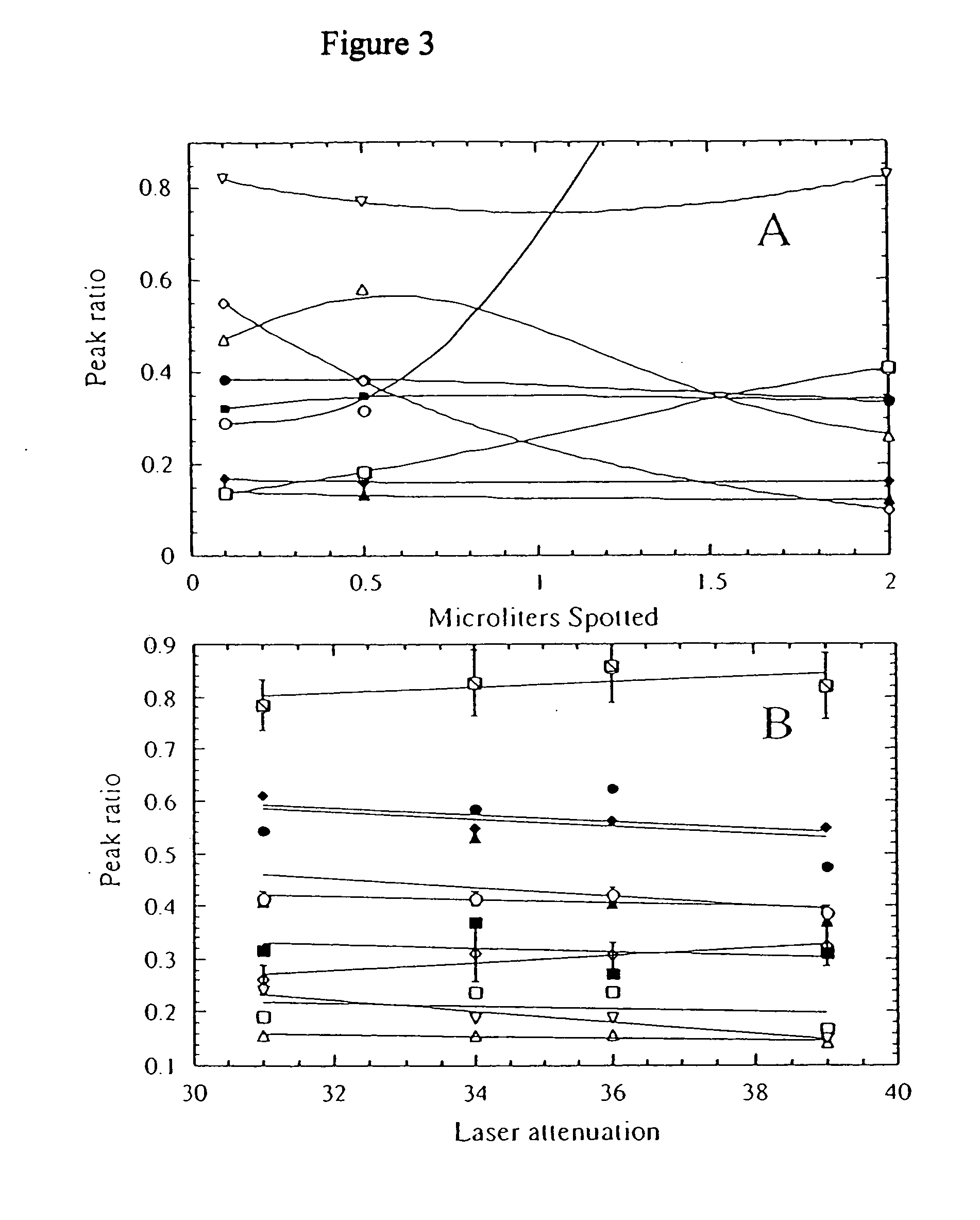[0154] Major profile changes are often associated with
severe disease such as
sepsis, which produce profiles that are unlike any that are found in a
normal population. In the case of
sepsis, a
protein profile may be used for
disease diagnosis without reference to a baseline value. However, lack of a baseline value may cause overestimation or underestimation of the
protein profile change. For example, an individual with a
steady state value for the 9713 / 9422 ratio of 0.2 will have a 4-fold change when the ratio is 0.8 and would be characterized as very aberrant, even though the actual value is within the range for healthy persons. This would result in underestimation of the illness level of that person. On the other hand, a person with a normal
steady state ratio of 0.8 may show a value of 1.6 with less illness than the first individual with an actual value of 0.8. Accordingly, an
advantage of the invention is that comparison of protein profiles prepared at different times may avoid overestimation or underestimation of disease. Thus,
full recovery from
sepsis is indicated when the
protein profile reaches a
steady state level that stops undergoing change, signifying that the individual has reached
homeostasis with respect to the
protein profile. Furthermore, the length of time a person spends in a highly altered protein state can also be used to predict the outcome of a disease. For example, a person is thought to be able to tolerate a short period of time with an extremely altered protein profile, but is thought to be less likely to survive if the protein profile is altered for an extended period of time. The length of time a patient may be able to survive with a severely altered protein profile will depend on health status, age and other factors at the time of illness.
[0155] A protein profile may also be followed over time to monitor a course of therapy. For example, the progress of a patient receiving treatment for
graft rejection may be followed through monitoring the protein profile of the patient over time to determine if the treatment scheme is effective in reducing or eliminating
graft rejection. In another example, a patient being treated for diabetes could be monitored using the methods described herein to determine if a therapeutic scheme was able to decrease the change in the patient's protein profile in response to
caloric intake, such as
ingestion of food or a food substitute. In another example, the protein profile of a patient being treated for emphysema could be monitored over time to determine if the treatment scheme decreased the quantity of
protein degradation products present in a bodily fluid from the patient, such as
bronchoalveolar lavage fluid or
urine. In another example, the protein profile of a patient receiving
chemotherapy could be followed to monitor whether the therapeutic scheme causes an undesired level of
cell death within the patient based on the presence of
protein degradation products in the bodily fluids of the patient. This can also apply to changes in the protein profile that suggest excessive damage resulting in aberrant ratios of normal proteins of the profile. Those of skill in the art realize that the method of the invention can be used to monitor and follow the progression of numerous treatment schemes and diseases.
[0156] Some disease states produce additional peaks in the protein profile of an individual that is suffering from a disease. These additional protein peaks can be used to diagnose the disease. C-reactive protein (CRP) analysis is commonly used to diagnose a disease involving an acute phase reactant. Acute phase reactants can be used as a test for inflammatory diseases, infections and neoplastic diseases. A major example of an acute phase reactant is
serum amyloid A (SAA), which was determined to become a dominant protein in
severe sepsis. The distribution of SAA isoforms was detected as well as several partial degradation products of SAA. It is thought that the distribution of these components is useful in diagnosis. While these forms of SAA have been detected by
mass spectrometry after
antibody precipitation (Kiernan et al., FEBS Lett., 537:166 (2003)), the
mass spectroscopy based
analysis method described herein offers the advantages over previous methods that include speed, greater
cost effectiveness, and simultaneous analysis of additional components. CRP may be used to detect early postoperative
wound infection and to follow therapeutic response to anti-inflammatory agents. Very sensitive assays for CRP are thought to be a useful indicator for susceptibility to cardiac disease. Additional diseases where CRP and by
inference SAA, may prove useful as a diagnostic tool include, but are not limited to,
heart disease / atherosclerosis,
stroke,
obesity, dental disease,
blood sugar disorders, Alzheimer's disease,
arthritis,
cancer, viral diseases, smoking related disease, disease related to the use of estradiol with or without progestagens in post-menopausal women, bacterial infection and aging.
[0157] Analysis of the
plasma protein profile revealed that, while
plasma contains a limited number of components, a surprising number of features were detected in the protein profiles. For example, very accurate ratios of the apolipoprotein C family of proteins are thought to reflect
lipoprotein structure and content so that changes in these proteins may be direct or indirect consequences of other events. The approach also detected several levels of
glycosylation associated with O-linked N-
acetylgalactosamine. The distribution of these glycoforms is thought to indicate the health of the organ of
biosynthesis or may detect the presence of glycosidase enzymes in the blood.
Transthyretin was found to represent the level of free sulfhydryl groups in the blood. Variations of sulflydryl modifications such as sulfonylation of TTr have been linked to a number of
severe disease states, such as end stage
liver disease and homocysteinuria (Lim et al., J. Biol. Chem., 278:49707-49713 (2003); Saraiva,
Hum. Mutat., 17:493-503 (2001); Kishikawa et al., Biochim. Biophys. Acta., 1588:135-138 (2002), Zhang and Kelly,
Biochemistry, 42: 8756-8761 (2003)). Lowered free sulfhydryl levels of TTr may also arise from
oxidative activity in the blood, another aspect of disease. In the sample
population studied to date, a high level of sulfonylated TTr was observed in
graft versus host disease (GVHD) and adolescent
obesity insulin resistance. Other
mass spectrometry methods have evaluated TTr modifications after
antibody precipitation or by an inline analysis (Lim et al., J. Biol. Chem., 278:49707-49713 (2003)). However, the method of the invention offers the advantages of speed and simplicity as well as simultaneous analysis of several other components.
[0158] The present invention may be used to diagnose and predict the outcome of
graft versus host disease.
Graft versus host disease (GVHD) is a frequent and life threatening complication of allogeneic
hematopoietic cell transplantation (HCT). Murine studies demonstrate that GVHD is a multi-step process involving
host tissue injury induced by the preparative
chemotherapy regiment. This leads to the activation of resident
antigen presenting cells (APCs) that in turn, activate donor T cells. Some of the T cells then recognize alloantigen on host tissues, proliferate and elaborate soluble proteins (cytokines, chemokines, etc.) that further recruit and activate lymphocytes. The process culminates in an immune mediated
attack of recipient target tissues by donor T cells (Ferrara et al., Biol. Blood Marrow Trans., 5:347 (1999)). Clinically, acute GVHD manifests as a syndrome of
skin rash,
diarrhea and hepatic dysfunction. A number of
clinical variables influence the incidence and severity of GVHD, including the degree of
major histocompatibility complex (MHC) matching between donor and recipient, the graft source (
peripheral blood stem cells (PBSC) versus
umbilical cord blood (UCB) versus
bone marrow (BM)) and the ages of the donor and recipient. Despite this, acute GVHD occurs frequently (about 10-40% of patients) and accounts for significant morbidity and mortality. Even though GVHD is a common complication there are no definitive tests other than
tissue biopsy and even
biopsy may yield equivocal results. This is a major obstacle since it is widely believed that GVHD should be promptly treated when detected. In fact, studies demonstrate that the early institution of GVHD treatment improves outcome (MacMillan et al., Biol. Blood Marrow Trans., 8:40 (2002)). Thus, serum based assays to detect sub-clinical GVHD or to establish the diagnosis, as described herein, are thought to have a considerable
impact on the management of patients.
[0159] The method of the invention can be used to monitor stages or an immune response in an
organism. For example, a mild immune response can be detected by the appearance of the new component at m / z=4152, an intermediate immune response can be detected by determining the level of
protein oxidation of TTr and a strong immune response is characterized by SAA production.
 Login to View More
Login to View More 


